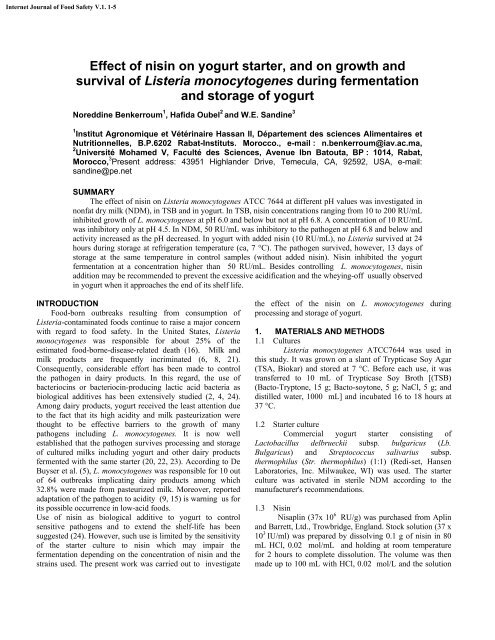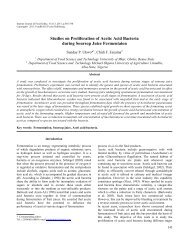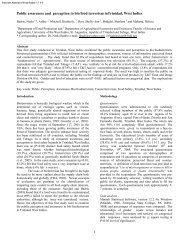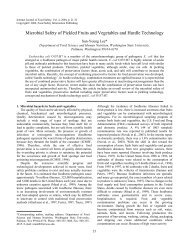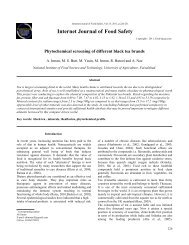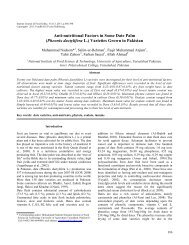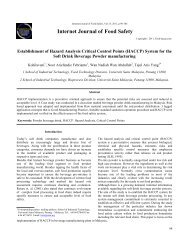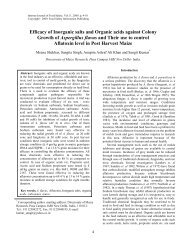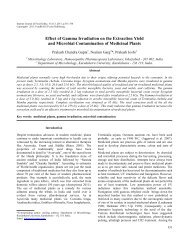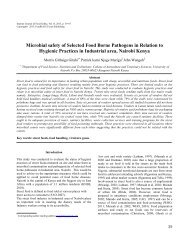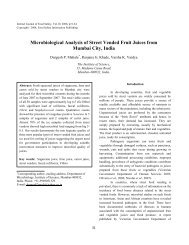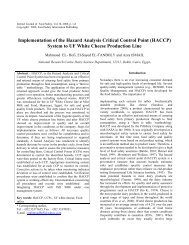Effect of nisin on yogurt starter, and on growth and survival of ...
Effect of nisin on yogurt starter, and on growth and survival of ...
Effect of nisin on yogurt starter, and on growth and survival of ...
You also want an ePaper? Increase the reach of your titles
YUMPU automatically turns print PDFs into web optimized ePapers that Google loves.
Internet Journal <str<strong>on</strong>g>of</str<strong>on</strong>g> Food Safety V.1. 1-5<br />
<str<strong>on</strong>g>Effect</str<strong>on</strong>g> <str<strong>on</strong>g>of</str<strong>on</strong>g> <str<strong>on</strong>g>nisin</str<strong>on</strong>g> <strong>on</strong> <strong>yogurt</strong> <strong>starter</strong>, <strong>and</strong> <strong>on</strong> <strong>growth</strong> <strong>and</strong><br />
<strong>survival</strong> <str<strong>on</strong>g>of</str<strong>on</strong>g> Listeria m<strong>on</strong>ocytogenes during fermentati<strong>on</strong><br />
<strong>and</strong> storage <str<strong>on</strong>g>of</str<strong>on</strong>g> <strong>yogurt</strong><br />
Noreddine Benkerroum 1 , Hafida Oubel 2 <strong>and</strong> W.E. S<strong>and</strong>ine 3<br />
1 Institut Agr<strong>on</strong>omique et Vétérinaire Hassan II, Département des sciences Alimentaires et<br />
Nutriti<strong>on</strong>nelles, B.P.6202 Rabat-Instituts. Morocco., e-mail : n.benkerroum@iav.ac.ma,<br />
2 Université Mohamed V, Faculté des Sciences, Avenue Ibn Batouta, BP : 1014, Rabat,<br />
Morocco, 3 Present address: 43951 Highl<strong>and</strong>er Drive, Temecula, CA, 92592, USA, e-mail:<br />
s<strong>and</strong>ine@pe.net<br />
SUMMARY<br />
The effect <str<strong>on</strong>g>of</str<strong>on</strong>g> <str<strong>on</strong>g>nisin</str<strong>on</strong>g> <strong>on</strong> Listeria m<strong>on</strong>ocytogenes ATCC 7644 at different pH values was investigated in<br />
n<strong>on</strong>fat dry milk (NDM), in TSB <strong>and</strong> in <strong>yogurt</strong>. In TSB, <str<strong>on</strong>g>nisin</str<strong>on</strong>g> c<strong>on</strong>centrati<strong>on</strong>s ranging from 10 to 200 RU/mL<br />
inhibited <strong>growth</strong> <str<strong>on</strong>g>of</str<strong>on</strong>g> L. m<strong>on</strong>ocytogenes at pH 6.0 <strong>and</strong> below but not at pH 6.8. A c<strong>on</strong>centrati<strong>on</strong> <str<strong>on</strong>g>of</str<strong>on</strong>g> 10 RU/mL<br />
was inhibitory <strong>on</strong>ly at pH 4.5. In NDM, 50 RU/mL was inhibitory to the pathogen at pH 6.8 <strong>and</strong> below <strong>and</strong><br />
activity increased as the pH decreased. In <strong>yogurt</strong> with added <str<strong>on</strong>g>nisin</str<strong>on</strong>g> (10 RU/mL), no Listeria survived at 24<br />
hours during storage at refrigerati<strong>on</strong> temperature (ca, 7 °C). The pathogen survived, however, 13 days <str<strong>on</strong>g>of</str<strong>on</strong>g><br />
storage at the same temperature in c<strong>on</strong>trol samples (without added <str<strong>on</strong>g>nisin</str<strong>on</strong>g>). Nisin inhibited the <strong>yogurt</strong><br />
fermentati<strong>on</strong> at a c<strong>on</strong>centrati<strong>on</strong> higher than 50 RU/mL. Besides c<strong>on</strong>trolling L. m<strong>on</strong>ocytogenes, <str<strong>on</strong>g>nisin</str<strong>on</strong>g><br />
additi<strong>on</strong> may be recommended to prevent the excessive acidificati<strong>on</strong> <strong>and</strong> the wheying-<str<strong>on</strong>g>of</str<strong>on</strong>g>f usually observed<br />
in <strong>yogurt</strong> when it approaches the end <str<strong>on</strong>g>of</str<strong>on</strong>g> its shelf life.<br />
INTRODUCTION<br />
Food-born outbreaks resulting from c<strong>on</strong>sumpti<strong>on</strong> <str<strong>on</strong>g>of</str<strong>on</strong>g><br />
Listeria-c<strong>on</strong>taminated foods c<strong>on</strong>tinue to raise a major c<strong>on</strong>cern<br />
with regard to food safety. In the United States, Listeria<br />
m<strong>on</strong>ocytogenes was resp<strong>on</strong>sible for about 25% <str<strong>on</strong>g>of</str<strong>on</strong>g> the<br />
estimated food-borne-disease-related death (16). Milk <strong>and</strong><br />
milk products are frequently incriminated (6, 8, 21).<br />
C<strong>on</strong>sequently, c<strong>on</strong>siderable effort has been made to c<strong>on</strong>trol<br />
the pathogen in dairy products. In this regard, the use <str<strong>on</strong>g>of</str<strong>on</strong>g><br />
bacteriocins or bacteriocin-producing lactic acid bacteria as<br />
biological additives has been extensively studied (2, 4, 24).<br />
Am<strong>on</strong>g dairy products, <strong>yogurt</strong> received the least attenti<strong>on</strong> due<br />
to the fact that its high acidity <strong>and</strong> milk pasteurizati<strong>on</strong> were<br />
thought to be effective barriers to the <strong>growth</strong> <str<strong>on</strong>g>of</str<strong>on</strong>g> many<br />
pathogens including L. m<strong>on</strong>ocytogenes. It is now well<br />
established that the pathogen survives processing <strong>and</strong> storage<br />
<str<strong>on</strong>g>of</str<strong>on</strong>g> cultured milks including <strong>yogurt</strong> <strong>and</strong> other dairy products<br />
fermented with the same <strong>starter</strong> (20, 22, 23). According to De<br />
Buyser et al. (5), L. m<strong>on</strong>ocytogenes was resp<strong>on</strong>sible for 10 out<br />
<str<strong>on</strong>g>of</str<strong>on</strong>g> 64 outbreaks implicating dairy products am<strong>on</strong>g which<br />
32.8% were made from pasteurized milk. Moreover, reported<br />
adaptati<strong>on</strong> <str<strong>on</strong>g>of</str<strong>on</strong>g> the pathogen to acidity (9, 15) is warning us for<br />
its possible occurrence in low-acid foods.<br />
Use <str<strong>on</strong>g>of</str<strong>on</strong>g> <str<strong>on</strong>g>nisin</str<strong>on</strong>g> as biological additive to <strong>yogurt</strong> to c<strong>on</strong>trol<br />
sensitive pathogens <strong>and</strong> to extend the shelf-life has been<br />
suggested (24). However, such use is limited by the sensitivity<br />
<str<strong>on</strong>g>of</str<strong>on</strong>g> the <strong>starter</strong> culture to <str<strong>on</strong>g>nisin</str<strong>on</strong>g> which may impair the<br />
fermentati<strong>on</strong> depending <strong>on</strong> the c<strong>on</strong>centrati<strong>on</strong> <str<strong>on</strong>g>of</str<strong>on</strong>g> <str<strong>on</strong>g>nisin</str<strong>on</strong>g> <strong>and</strong> the<br />
strains used. The present work was carried out to investigate<br />
the effect <str<strong>on</strong>g>of</str<strong>on</strong>g> the <str<strong>on</strong>g>nisin</str<strong>on</strong>g> <strong>on</strong> L. m<strong>on</strong>ocytogenes during<br />
processing <strong>and</strong> storage <str<strong>on</strong>g>of</str<strong>on</strong>g> <strong>yogurt</strong>.<br />
1. MATERIALS AND METHODS<br />
1.1 Cultures<br />
Listeria m<strong>on</strong>ocytogenes ATCC7644 was used in<br />
this study. It was grown <strong>on</strong> a slant <str<strong>on</strong>g>of</str<strong>on</strong>g> Trypticase Soy Agar<br />
(TSA, Biokar) <strong>and</strong> stored at 7 °C. Before each use, it was<br />
transferred to 10 mL <str<strong>on</strong>g>of</str<strong>on</strong>g> Trypticase Soy Broth [(TSB)<br />
(Bacto-Trypt<strong>on</strong>e, 15 g; Bacto-soyt<strong>on</strong>e, 5 g; NaCl, 5 g; <strong>and</strong><br />
distilled water, 1000 mL] <strong>and</strong> incubated 16 to 18 hours at<br />
37 °C.<br />
1.2 Starter culture<br />
Commercial <strong>yogurt</strong> <strong>starter</strong> c<strong>on</strong>sisting <str<strong>on</strong>g>of</str<strong>on</strong>g><br />
Lactobacillus delbrueckii subsp. bulgaricus (Lb.<br />
Bulgaricus) <strong>and</strong> Streptococcus salivarius subsp.<br />
thermophilus (Str. thermophilus) (1:1) (Redi-set, Hansen<br />
Laboratories, Inc. Milwaukee, WI) was used. The <strong>starter</strong><br />
culture was activated in sterile NDM according to the<br />
manufacturer's recommendati<strong>on</strong>s.<br />
1.3 Nisin<br />
Nisaplin (37x 10 6 RU/g) was purchased from Aplin<br />
<strong>and</strong> Barrett, Ltd., Trowbridge, Engl<strong>and</strong>. Stock soluti<strong>on</strong> (37 x<br />
10 3 IU/ml) was prepared by dissolving 0.1 g <str<strong>on</strong>g>of</str<strong>on</strong>g> <str<strong>on</strong>g>nisin</str<strong>on</strong>g> in 80<br />
mL HCl, 0.02 mol/mL <strong>and</strong> holding at room temperature<br />
for 2 hours to complete dissoluti<strong>on</strong>. The volume was then<br />
made up to 100 mL with HCl, 0.02 mol/L <strong>and</strong> the soluti<strong>on</strong>
was filter-sterilized by passage through a 0.22-µm Millipore<br />
membrane <strong>and</strong> stored at -20 °C.<br />
1.4 <str<strong>on</strong>g>Effect</str<strong>on</strong>g> <str<strong>on</strong>g>of</str<strong>on</strong>g> Nisin <strong>on</strong> L. m<strong>on</strong>ocytogenes ATCC 7644<br />
1.4.1 Varying pH with c<strong>on</strong>stant <str<strong>on</strong>g>nisin</str<strong>on</strong>g> c<strong>on</strong>centrati<strong>on</strong><br />
Three series <str<strong>on</strong>g>of</str<strong>on</strong>g> test tubes c<strong>on</strong>taining 9 mL <str<strong>on</strong>g>of</str<strong>on</strong>g><br />
rec<strong>on</strong>stituted NDM (100 g/L) each were used. The tubes <str<strong>on</strong>g>of</str<strong>on</strong>g><br />
each series were adjusted to different pH values (6.8, 5.5 <strong>and</strong><br />
4.5) with citric acid. To the first series (test), <str<strong>on</strong>g>nisin</str<strong>on</strong>g> was added<br />
to a final c<strong>on</strong>centrati<strong>on</strong> <str<strong>on</strong>g>of</str<strong>on</strong>g> 50 RU/mL al<strong>on</strong>g with 0.1 mL <str<strong>on</strong>g>of</str<strong>on</strong>g> L.<br />
m<strong>on</strong>ocytogenes ATCC 7644 overnight (16 to 18h) culture (ca,<br />
10 6 cell/mL). To the sec<strong>on</strong>d series, <strong>on</strong>ly Listeria was added to<br />
the same c<strong>on</strong>centrati<strong>on</strong>. The third series was a negative c<strong>on</strong>trol<br />
to test the sterility <str<strong>on</strong>g>of</str<strong>on</strong>g> the medium; neither <str<strong>on</strong>g>nisin</str<strong>on</strong>g> nor the<br />
microorganism was added. Cultures were incubated at 37 °C<br />
<strong>and</strong> the <strong>growth</strong> <str<strong>on</strong>g>of</str<strong>on</strong>g> L. m<strong>on</strong>ocytogenes was m<strong>on</strong>itored by plate<br />
count <strong>on</strong> TSA at 0, 4, 7, 24 <strong>and</strong> 48 hours.<br />
1.4.2 Varying pH <strong>and</strong> <str<strong>on</strong>g>nisin</str<strong>on</strong>g> c<strong>on</strong>centrati<strong>on</strong><br />
A series <str<strong>on</strong>g>of</str<strong>on</strong>g> test tubes c<strong>on</strong>taining 9 to 10 mL <str<strong>on</strong>g>of</str<strong>on</strong>g> TSB<br />
each were used. The tubes <str<strong>on</strong>g>of</str<strong>on</strong>g> each series were adjusted to<br />
different pH values (6.8, 6.0, 5.5 <strong>and</strong> 5.0) with citric acid. For<br />
each pH, a different <str<strong>on</strong>g>nisin</str<strong>on</strong>g> c<strong>on</strong>centrati<strong>on</strong> was used (10, 50, 100,<br />
<strong>and</strong> 200 RU/mL). Tubes were inoculated with 0.1 mL <str<strong>on</strong>g>of</str<strong>on</strong>g> an<br />
overnight Listeria culture (16 to18 hours) <strong>and</strong> incubated at 37<br />
°C. Negative <strong>and</strong> positive c<strong>on</strong>trols were prepared as described<br />
above. Growth <str<strong>on</strong>g>of</str<strong>on</strong>g> the pathogen was m<strong>on</strong>itored by O.D.<br />
determinati<strong>on</strong>s at 600 nm at 0, 2, 4, 24 <strong>and</strong> 48 hours.<br />
1.5 <str<strong>on</strong>g>Effect</str<strong>on</strong>g> <str<strong>on</strong>g>of</str<strong>on</strong>g> Nisin <strong>on</strong> Yogurt Fermentati<strong>on</strong><br />
As <strong>yogurt</strong> <strong>starter</strong> is reported to be sensitive to <str<strong>on</strong>g>nisin</str<strong>on</strong>g> (12,<br />
13, 24) this preliminary experiment was carried out to<br />
determine the c<strong>on</strong>centrati<strong>on</strong> <str<strong>on</strong>g>of</str<strong>on</strong>g> <str<strong>on</strong>g>nisin</str<strong>on</strong>g> which can be used<br />
without affecting significantly normal <strong>yogurt</strong> processing <strong>and</strong><br />
acid producti<strong>on</strong>.<br />
Yogurt trials were c<strong>on</strong>ducted as follows: N<strong>on</strong>fat dry milk was<br />
added to raw milk to adjust fat <strong>and</strong> dry matter c<strong>on</strong>tents to<br />
approximately 17 <strong>and</strong> 150 g/L, respectively. After thorough<br />
mixing, pasteurizati<strong>on</strong> was performed in water bath at 80 °C<br />
(internal temperature) for 30 min. Of the pasteurized milk, 100<br />
milliliters were dispensed in plastic cups <strong>and</strong> inoculated with<br />
the <strong>yogurt</strong> <strong>starter</strong> activated as described above to the level <str<strong>on</strong>g>of</str<strong>on</strong>g><br />
20 mL/L. Nisin was added to the cups to a final c<strong>on</strong>centrati<strong>on</strong><br />
<str<strong>on</strong>g>of</str<strong>on</strong>g> 10, 50 or 100 RU/mL. A sample not c<strong>on</strong>taining <str<strong>on</strong>g>nisin</str<strong>on</strong>g> was<br />
used as a c<strong>on</strong>trol. The c<strong>on</strong>tainers were incubated at 43 °C until<br />
coagulati<strong>on</strong> (6 to 7 h), then transferred to the refrigerator (ca, 7<br />
°C). The pH <strong>and</strong> acidity were measured every hour until<br />
coagulati<strong>on</strong> then at 24 h. pH measurements were d<strong>on</strong>e with a<br />
Cris<strong>on</strong> pH meter using an Ingold combinati<strong>on</strong> electrode.<br />
Acidity was measured by titrati<strong>on</strong> with NaOH, 0.1 mol/L in<br />
presence <str<strong>on</strong>g>of</str<strong>on</strong>g> 10 g/L phenolphthalein soluti<strong>on</strong>.<br />
2.6. <str<strong>on</strong>g>Effect</str<strong>on</strong>g> <str<strong>on</strong>g>of</str<strong>on</strong>g> Nisin <strong>on</strong> Listeria m<strong>on</strong>ocytogenes in Yogurt<br />
Two series <str<strong>on</strong>g>of</str<strong>on</strong>g> <strong>yogurt</strong> cups were prepared as described<br />
above. Nisin was added to <strong>on</strong>e <str<strong>on</strong>g>of</str<strong>on</strong>g> them to a final c<strong>on</strong>centrati<strong>on</strong><br />
<str<strong>on</strong>g>of</str<strong>on</strong>g> 10 RU/mL. The sec<strong>on</strong>d was a positive c<strong>on</strong>trol. All cups<br />
were inoculated with 0.1 L (ca, 10 5 RU/mL) <str<strong>on</strong>g>of</str<strong>on</strong>g> an overnight<br />
Listeria culture. Samples were incubated at 43 o C until<br />
coagulati<strong>on</strong>. They were then stored in the refrigerator (ca, 7<br />
o C) <strong>and</strong> sampled for plate count <strong>on</strong> ASLM (1) at 1, 2, 3, 13<br />
<strong>and</strong> 15 days.<br />
2.7 Statistical analysis<br />
At least two replicates <str<strong>on</strong>g>of</str<strong>on</strong>g> each trial were d<strong>on</strong>e <strong>and</strong><br />
each determinati<strong>on</strong> was repeated twice. The mean <strong>and</strong><br />
st<strong>and</strong>ard deviati<strong>on</strong> <str<strong>on</strong>g>of</str<strong>on</strong>g> each determinati<strong>on</strong> were calculated.<br />
Student t-test <strong>and</strong> analysis <str<strong>on</strong>g>of</str<strong>on</strong>g> variance (P = 0.05) were used<br />
to analyze changes in pH, acidity <strong>and</strong> Listeriae cell numbers<br />
in NDM, TSB <strong>and</strong> <strong>yogurt</strong> samples.<br />
3. Results <strong>and</strong> discussi<strong>on</strong><br />
3.1 <str<strong>on</strong>g>Effect</str<strong>on</strong>g> <str<strong>on</strong>g>of</str<strong>on</strong>g> Nisin <strong>on</strong> L. m<strong>on</strong>ocytogenes at Different pH<br />
Values<br />
Growth <str<strong>on</strong>g>of</str<strong>on</strong>g> L. m<strong>on</strong>ocytogenes in NDM at different pH<br />
values in absence or presence <str<strong>on</strong>g>of</str<strong>on</strong>g> 50 RU/mL <str<strong>on</strong>g>of</str<strong>on</strong>g> <str<strong>on</strong>g>nisin</str<strong>on</strong>g> is<br />
shown in Table 1. It may be seen that numbers <str<strong>on</strong>g>of</str<strong>on</strong>g> L.<br />
m<strong>on</strong>ocytogenes increased at pH 6.8 in the c<strong>on</strong>trols (without<br />
<str<strong>on</strong>g>nisin</str<strong>on</strong>g>), while they decreased steadily in test samples<br />
c<strong>on</strong>taining 50 RU/mL <str<strong>on</strong>g>of</str<strong>on</strong>g> <str<strong>on</strong>g>nisin</str<strong>on</strong>g>. Similar results were obtained<br />
at pH 5.5. At pH 4.5, a decrease in Listeria counts was<br />
observed in both test <strong>and</strong> c<strong>on</strong>trol samples; however, the<br />
pathogen was eliminated from the test samples within 24<br />
hours while, in the c<strong>on</strong>trol, few cells were still viable even<br />
at 48 hours. The same behavior was observed at pH 5.0<br />
(Table1). Similar results were previously reported in TSB<br />
but with a higher <str<strong>on</strong>g>nisin</str<strong>on</strong>g> c<strong>on</strong>centrati<strong>on</strong> (e.g 37.10 2 RU/mL)<br />
(Benkerroum S<strong>and</strong>ine). These data suggest that 50 RU/mL<br />
<str<strong>on</strong>g>of</str<strong>on</strong>g> <str<strong>on</strong>g>nisin</str<strong>on</strong>g> is effective in the c<strong>on</strong>trol <str<strong>on</strong>g>of</str<strong>on</strong>g> L. m<strong>on</strong>ocytogenes in<br />
milk <strong>and</strong> dairy products. A c<strong>on</strong>centrati<strong>on</strong> <str<strong>on</strong>g>of</str<strong>on</strong>g> 10 to 500 RU/g<br />
has been recommended in food preservati<strong>on</strong> in general (7).<br />
In view <str<strong>on</strong>g>of</str<strong>on</strong>g> these results <strong>and</strong> c<strong>on</strong>sidering the fact that in<br />
practice there is a tendency to minimize the amount <str<strong>on</strong>g>of</str<strong>on</strong>g> an<br />
additive in food preservati<strong>on</strong>, this experiment was carried<br />
out in TSB using different combinati<strong>on</strong>s <str<strong>on</strong>g>of</str<strong>on</strong>g> pH <strong>and</strong> <str<strong>on</strong>g>nisin</str<strong>on</strong>g><br />
c<strong>on</strong>centrati<strong>on</strong>s. At pH 6.8, no c<strong>on</strong>centrati<strong>on</strong> was inhibitory<br />
to L. m<strong>on</strong>ocytogenes; no significant difference (P >0.05)<br />
between O.D. reached after 48 hours in samples c<strong>on</strong>taining<br />
up to 200 RU/mL <strong>and</strong> the c<strong>on</strong>trol, was observed (Fig 1, A).<br />
At pH 6.0, 5.5 <strong>and</strong> 5.0, however, 50, 100 <strong>and</strong> 200 RU/mL<br />
were all effective (Figures 1B, 1C <strong>and</strong> 1D). A c<strong>on</strong>centrati<strong>on</strong><br />
<str<strong>on</strong>g>of</str<strong>on</strong>g> 10 RU/mL had no significant (P> 0.05) effect <strong>on</strong> L.<br />
m<strong>on</strong>ocytogenes at pH 6.8 <strong>and</strong> 5.5 but was significantly<br />
(p
Table 1: <str<strong>on</strong>g>Effect</str<strong>on</strong>g> <str<strong>on</strong>g>of</str<strong>on</strong>g> pH <strong>and</strong> added <str<strong>on</strong>g>nisin</str<strong>on</strong>g> (50 RU/mL) <strong>on</strong> <strong>growth</strong> <str<strong>on</strong>g>of</str<strong>on</strong>g> Listeria m<strong>on</strong>ocytogenes (log CFU/mL) in rec<strong>on</strong>stituted n<strong>on</strong>fat<br />
dry milk incubated at 37 °C.<br />
PH<br />
6.8 5.5 5.0 4.5<br />
Hours +<str<strong>on</strong>g>nisin</str<strong>on</strong>g> - <str<strong>on</strong>g>nisin</str<strong>on</strong>g> + <str<strong>on</strong>g>nisin</str<strong>on</strong>g> - <str<strong>on</strong>g>nisin</str<strong>on</strong>g> + <str<strong>on</strong>g>nisin</str<strong>on</strong>g> -<str<strong>on</strong>g>nisin</str<strong>on</strong>g> +<str<strong>on</strong>g>nisin</str<strong>on</strong>g> -<str<strong>on</strong>g>nisin</str<strong>on</strong>g><br />
0 6,0 6,0 6,0 6,0 6,0 6,0 6,0 6,0<br />
4 6.7(0.29) 1 7.5(0.53) 6.4(0.59) 6.7(0.56) 5.6(0.82) 6.2(0.16) 4.7(0.37) 5.2(0.70)<br />
7 7.8(0.18) 8.9(0.29) 6.6(0.66) 7.1(0.26) 5.7(0.26) 5.8(0.48) 4.5(0.38) 4.7(0.29)<br />
24 3.8(0.63) 9.5(0.41) 2.8(0.55) 6.9(0.42) 3.3(0.53) 5.8(0.77) 0.0(0) 2.8(073)<br />
48 1.5(0.50) 9.5(0.29) 1.2(0.30) 8.3(0.33) 0.0(0) 2.4(0.43) 0.0(0) 0.8(0.85)<br />
Values are means <str<strong>on</strong>g>of</str<strong>on</strong>g> four determinati<strong>on</strong>s.<br />
1 St<strong>and</strong>ard deviati<strong>on</strong>s in parenthesis.<br />
due to a decrease in its solubility. Wei <strong>and</strong> Norman (25)<br />
investigated the effect <str<strong>on</strong>g>of</str<strong>on</strong>g> pH <strong>on</strong> <str<strong>on</strong>g>nisin</str<strong>on</strong>g> solubility <strong>and</strong> found that<br />
it decreases exp<strong>on</strong>entially from pH 2.0 to 6.0 <strong>and</strong> that it is<br />
almost insoluble around pH 8.0. However, we showed in<br />
previous work (2) that a <str<strong>on</strong>g>nisin</str<strong>on</strong>g> c<strong>on</strong>centrati<strong>on</strong> <str<strong>on</strong>g>of</str<strong>on</strong>g> 37.10 2 RU/mL<br />
is effective against L. m<strong>on</strong>ocytogenes at pH7.0 in TSB.<br />
Moreover, Mohamed et al., (17) showed that <str<strong>on</strong>g>nisin</str<strong>on</strong>g> is active<br />
against L. m<strong>on</strong>ocytogenes at pH 7.4 <strong>and</strong> that <strong>on</strong>ly 32 RU/ml<br />
were necessary to inhibit this strain at 37 °C. They also<br />
showed that the sensitivity <str<strong>on</strong>g>of</str<strong>on</strong>g> this strain decreases with the<br />
temperature <str<strong>on</strong>g>of</str<strong>on</strong>g> incubati<strong>on</strong>. A <str<strong>on</strong>g>nisin</str<strong>on</strong>g> c<strong>on</strong>centrati<strong>on</strong> <str<strong>on</strong>g>of</str<strong>on</strong>g> 256<br />
RU/ml was required to inhibit the same strain at 22 °C at the<br />
same pH. This amount was 16-fold reduced at pH 5.5 at the<br />
same temperature. Decrease in <str<strong>on</strong>g>nisin</str<strong>on</strong>g> activity at pH values<br />
above 7.0 may also be due to a partial inactivati<strong>on</strong> <str<strong>on</strong>g>of</str<strong>on</strong>g> the<br />
bacteriocin with subsequent reducti<strong>on</strong> <str<strong>on</strong>g>of</str<strong>on</strong>g> the initial<br />
c<strong>on</strong>centrati<strong>on</strong> or to the polymerizati<strong>on</strong> <str<strong>on</strong>g>of</str<strong>on</strong>g> the molecule (12). In<br />
fact, <str<strong>on</strong>g>nisin</str<strong>on</strong>g> activity was completely <strong>and</strong> irreversibly lost after 4<br />
days <str<strong>on</strong>g>of</str<strong>on</strong>g> storage at pH 7.0 <strong>and</strong> ambient temperature<br />
(unpublished data). Our results show that <str<strong>on</strong>g>nisin</str<strong>on</strong>g> acti<strong>on</strong> at a<br />
given pH depends <strong>on</strong> the c<strong>on</strong>centrati<strong>on</strong> <strong>and</strong> the medium used.<br />
In effect, 50 RU/mL resulted in more than 4 log units<br />
reducti<strong>on</strong> in Listeria counts in NDM at pH 6.8 after 48 hours;<br />
while, 200 RU/mL had <strong>on</strong>ly a slight effect <strong>on</strong> the pathogen in<br />
TSB at the same pH (Table 1 <strong>and</strong> Figure 1, respectively).<br />
3.2 <str<strong>on</strong>g>Effect</str<strong>on</strong>g> <str<strong>on</strong>g>of</str<strong>on</strong>g> Nisin <strong>on</strong> Yogurt Fermentati<strong>on</strong><br />
Figure 2 shows the decrease in the pH <strong>and</strong> the<br />
increase in acidity during fermentati<strong>on</strong> <str<strong>on</strong>g>of</str<strong>on</strong>g> <strong>yogurt</strong> c<strong>on</strong>taining<br />
different c<strong>on</strong>centrati<strong>on</strong>s <str<strong>on</strong>g>of</str<strong>on</strong>g> <str<strong>on</strong>g>nisin</str<strong>on</strong>g>. A <str<strong>on</strong>g>nisin</str<strong>on</strong>g> c<strong>on</strong>centrati<strong>on</strong> <str<strong>on</strong>g>of</str<strong>on</strong>g> 50<br />
RU/mL or less had no noticeable effect <strong>on</strong> <strong>yogurt</strong><br />
fermentati<strong>on</strong>. The pH dropped <strong>and</strong> the acidity increased in<br />
the same way as in the c<strong>on</strong>trol. Milk coagulati<strong>on</strong> in all<br />
samples was normal; it occurred from 6 to 7 hours <strong>and</strong> the<br />
curd was firm <strong>and</strong> without syneresis. However, in the<br />
samples c<strong>on</strong>taining 100 RU/mL <str<strong>on</strong>g>of</str<strong>on</strong>g> <str<strong>on</strong>g>nisin</str<strong>on</strong>g>, fermentati<strong>on</strong> was<br />
greatly retarded <strong>and</strong> the curd had an abnormal, viscous<br />
body. After 15 days, the titratable acidity <strong>and</strong> the pH <str<strong>on</strong>g>of</str<strong>on</strong>g><br />
<strong>yogurt</strong> c<strong>on</strong>taining 100 RU/mL <str<strong>on</strong>g>of</str<strong>on</strong>g> <str<strong>on</strong>g>nisin</str<strong>on</strong>g> averaged 0.6% <strong>and</strong><br />
4.5, respectively, while in the c<strong>on</strong>trol, acidity was about<br />
0.9% <strong>and</strong> pH 4.0. This result is due to the fact that <str<strong>on</strong>g>nisin</str<strong>on</strong>g> is<br />
inhibitory to the <strong>yogurt</strong> <strong>starter</strong> as was shown herein <strong>and</strong><br />
elsewhere (12, 13). Several strains <str<strong>on</strong>g>of</str<strong>on</strong>g> lactobacilli have been<br />
tested for their sensitivity to <str<strong>on</strong>g>nisin</str<strong>on</strong>g> <strong>and</strong> found that the MIC<br />
values ranged between 35 <strong>and</strong> 100 RU/mL for Lb.<br />
delbueckii subsp. bulgaricus strains at optimal <strong>growth</strong><br />
c<strong>on</strong>diti<strong>on</strong>s <strong>and</strong> when an inuculum <str<strong>on</strong>g>of</str<strong>on</strong>g> 10 mL/L was used.<br />
These values doubled for an inoculum <str<strong>on</strong>g>of</str<strong>on</strong>g> 20 mL/L (13). As<br />
matter <str<strong>on</strong>g>of</str<strong>on</strong>g> fact, a moderate delay in <strong>yogurt</strong> acidificati<strong>on</strong> may<br />
be suitable in <strong>yogurt</strong> technology since in the c<strong>on</strong>venti<strong>on</strong>al<br />
process the product usually develop too much acidity<br />
towards the end <str<strong>on</strong>g>of</str<strong>on</strong>g> the storage <strong>and</strong> wheys-<str<strong>on</strong>g>of</str<strong>on</strong>g>f. According to<br />
Bayoumi (3), <str<strong>on</strong>g>nisin</str<strong>on</strong>g> additi<strong>on</strong> to the level <str<strong>on</strong>g>of</str<strong>on</strong>g> 50 AU/ml<br />
prevents such defect resulting in 7 days increase <str<strong>on</strong>g>of</str<strong>on</strong>g> the<br />
shelf-life without affecting the sensory characteristics.<br />
3.3 <str<strong>on</strong>g>Effect</str<strong>on</strong>g> <str<strong>on</strong>g>of</str<strong>on</strong>g> <str<strong>on</strong>g>nisin</str<strong>on</strong>g> <strong>on</strong> L. m<strong>on</strong>ocytogenes in <strong>yogurt</strong>:
Figure 3 shows the behavior <str<strong>on</strong>g>of</str<strong>on</strong>g> L. m<strong>on</strong>ocytogenes in <strong>yogurt</strong> in<br />
the presence <strong>and</strong> absence <str<strong>on</strong>g>of</str<strong>on</strong>g> <str<strong>on</strong>g>nisin</str<strong>on</strong>g> during storage at 7 °C.<br />
Although a significant decrease in Listeria counts was<br />
observed in <strong>yogurt</strong> without <str<strong>on</strong>g>nisin</str<strong>on</strong>g>, the pathogen survived<br />
manufacture <strong>and</strong> 13 days <str<strong>on</strong>g>of</str<strong>on</strong>g> storage at 7 o C. However, in<br />
<strong>yogurt</strong> c<strong>on</strong>taining 10 RU/mL <str<strong>on</strong>g>of</str<strong>on</strong>g> <str<strong>on</strong>g>nisin</str<strong>on</strong>g>, no Listeria was found in<br />
1-ml samples at or after 24 hours. Survival <str<strong>on</strong>g>of</str<strong>on</strong>g> pathogens in<br />
fermented dairy products, in spite <str<strong>on</strong>g>of</str<strong>on</strong>g> the antag<strong>on</strong>istic effect <str<strong>on</strong>g>of</str<strong>on</strong>g><br />
lactic acid bacteria used as <strong>starter</strong> cultures is well documented<br />
(4, 5, 6). In <strong>yogurt</strong> <strong>and</strong> in other dairy products fermented with<br />
the same <strong>starter</strong> [e.g. Lb. bulgaricus, <strong>and</strong> Str. thermophilus<br />
(ST:LB::1:1)] such as some cultured milks <strong>and</strong> Feta cheese, L.<br />
m<strong>on</strong>ocytogenes survives manufacture <strong>and</strong> storage (20, 21).<br />
Papageorgiou <strong>and</strong> Marth (18) showed that L. m<strong>on</strong>ocytogenes<br />
could survive the manufacture <strong>and</strong> more than 90 days <str<strong>on</strong>g>of</str<strong>on</strong>g><br />
storage at 4 °C in Feta cheese. This bacterium survived in<br />
cultured milk fermented with STLB <strong>and</strong> in <strong>yogurt</strong> for 1 to 12<br />
weeks <strong>and</strong> 1 to 12 days, respectively (19).<br />
The same authors showed that <strong>survival</strong> <str<strong>on</strong>g>of</str<strong>on</strong>g> L. m<strong>on</strong>ocytogenes in<br />
<strong>yogurt</strong> depended <strong>on</strong> the size <str<strong>on</strong>g>of</str<strong>on</strong>g> Listeria <strong>and</strong> <strong>starter</strong> culture<br />
inocula, the final pH reached, the temperature <strong>and</strong> durati<strong>on</strong> <str<strong>on</strong>g>of</str<strong>on</strong>g><br />
the fermentati<strong>on</strong>, <strong>and</strong> Listeria strain. Shaack <strong>and</strong> Marth (22)<br />
showed that L. m<strong>on</strong>ocytogenes survives <strong>on</strong>ly between 9 to 15<br />
hours during the actual fermentati<strong>on</strong> process <str<strong>on</strong>g>of</str<strong>on</strong>g> <strong>yogurt</strong>.<br />
However, in a typical <strong>yogurt</strong> fermentati<strong>on</strong> <str<strong>on</strong>g>of</str<strong>on</strong>g> 4 to 6 hours,<br />
Listeria was able to grow during fermentati<strong>on</strong> <strong>and</strong> then<br />
survive during storage at 4 °C. Lammerding <strong>and</strong> Doyle (14)<br />
also could recover L. m<strong>on</strong>ocytogenes from <strong>yogurt</strong> after 7 days<br />
<str<strong>on</strong>g>of</str<strong>on</strong>g> storage at 4 °C, although the initial inoculum was relatively<br />
low (about 32 x 10 2 CFU/mL).<br />
4. C<strong>on</strong>clusi<strong>on</strong><br />
These results c<strong>on</strong>firm that food processors should not<br />
solely rely <strong>on</strong> pasteurizati<strong>on</strong> <strong>and</strong> fermentati<strong>on</strong> to insure full<br />
protecti<strong>on</strong> <strong>and</strong> safety <str<strong>on</strong>g>of</str<strong>on</strong>g> fermented milk products. Some food<br />
grade additives may also be used in additi<strong>on</strong> al<strong>on</strong>g with Good<br />
Manufacture Practices. Nisin proved to be effective in<br />
c<strong>on</strong>trolling the <strong>growth</strong> <str<strong>on</strong>g>of</str<strong>on</strong>g> L. m<strong>on</strong>ocytogenes in both cottage<br />
cheese (2) <strong>and</strong> <strong>yogurt</strong> (the present study). For the latter, the<br />
amount <str<strong>on</strong>g>of</str<strong>on</strong>g> <str<strong>on</strong>g>nisin</str<strong>on</strong>g> used should inhibit the pathogen without<br />
harming significantly the <strong>yogurt</strong> <strong>starter</strong>. In our case, a <str<strong>on</strong>g>nisin</str<strong>on</strong>g><br />
c<strong>on</strong>centrati<strong>on</strong> <str<strong>on</strong>g>of</str<strong>on</strong>g> up to 50 RU/mL had no adverse effect <strong>on</strong> the<br />
<strong>yogurt</strong> <strong>starter</strong> we used (e.g Rediset). Moreover, <str<strong>on</strong>g>nisin</str<strong>on</strong>g> additi<strong>on</strong><br />
to <strong>yogurt</strong> may play a beneficial role in keeping <strong>yogurt</strong> acidity<br />
from dropping too low during storage <strong>and</strong> thus prevents<br />
deteriorati<strong>on</strong> <str<strong>on</strong>g>of</str<strong>on</strong>g> its sensory attributes <strong>and</strong> extends its shelf-life.<br />
Such use is <str<strong>on</strong>g>of</str<strong>on</strong>g> more interest in developing countries where<br />
<strong>yogurt</strong> is rarely stored at refrigerati<strong>on</strong> temperature when<br />
marketed. Nisin (50 RU/mL) was added to rec<strong>on</strong>stituted NDM<br />
previously adjusted to different pH values al<strong>on</strong>g with L.<br />
m<strong>on</strong>ocytogenes ATCC 7644 (ca., 10 6 cell/mL). The<br />
experiment was c<strong>on</strong>ducted against a positive (<strong>on</strong>ly Listeria<br />
was added) <strong>and</strong> a negative (without added <str<strong>on</strong>g>nisin</str<strong>on</strong>g> or Listeria)<br />
c<strong>on</strong>trols. Growth <str<strong>on</strong>g>of</str<strong>on</strong>g> L. m<strong>on</strong>ocytogenes ATCC 7644 was<br />
m<strong>on</strong>itored at 37 °C by plate count <strong>on</strong> TSA at 0, 4, 7, 24 <strong>and</strong> 48<br />
hours.<br />
REFERRENCES<br />
[1] Al-Zoreky, N <strong>and</strong> S<strong>and</strong>ine, W.E. Highly selective<br />
medium for isalati<strong>on</strong> <str<strong>on</strong>g>of</str<strong>on</strong>g> Listeria m<strong>on</strong>ocytogenes from<br />
food. Appl. Envir<strong>on</strong>. Microbiol., 56 (1990) 30145-<br />
30157<br />
[2] Benkerroum, N., <strong>and</strong> S<strong>and</strong>ine, W. E. Inhibitory<br />
acti<strong>on</strong> <str<strong>on</strong>g>of</str<strong>on</strong>g> <str<strong>on</strong>g>nisin</str<strong>on</strong>g> against Listeria m<strong>on</strong>ocytogenes. J.<br />
Dairy Sc., 71 (1988) 3237-3245.<br />
[3] Bayoumi S., Nisin <strong>and</strong> Yogurt manufacture. Chem.<br />
Microbiol. Technol. Lebensm. 13 (1991) 65-69.<br />
[4] Benkerroum, N., Oubel, H., Zahar , M., Dlia, S.,<br />
Filali-Maltouf, A., Isolati<strong>on</strong> <str<strong>on</strong>g>of</str<strong>on</strong>g> a bacteriocinproducing<br />
Lactococcus lactis subsp. lactis <strong>and</strong><br />
applicati<strong>on</strong> to c<strong>on</strong>trol Listeria m<strong>on</strong>ocytogenes in<br />
Moroccan Jben, J. Appl. Microbiol., 89 (2000) 960-<br />
969.<br />
[5] De Buyser M-L., Dufour B., Maire M., Lafarge V.,<br />
Implicati<strong>on</strong> <str<strong>on</strong>g>of</str<strong>on</strong>g> milk <strong>and</strong> milk products in food-borne<br />
diseases in France <strong>and</strong> in different industrialized<br />
countries, Int. J. Food Microbiol., 67 (2001) 1-17.<br />
[6] D<strong>on</strong>nely, C.W., C<strong>on</strong>cerns <str<strong>on</strong>g>of</str<strong>on</strong>g> microbial pathogens<br />
in associati<strong>on</strong> with dairy foods. J. Dairy Sci., 73<br />
(1990) 1656-1661.<br />
[7] Eapen,K C., S<strong>and</strong>aran, R., Vijaraghavan, P. K.,<br />
The present status <strong>on</strong> the use <str<strong>on</strong>g>of</str<strong>on</strong>g> <str<strong>on</strong>g>nisin</str<strong>on</strong>g> in processed<br />
foods. J. Food Sci. Technol., 20 (1983) 231-240.<br />
[8] Farber J.M., Peterkin P.I., Listeria m<strong>on</strong>ocytogenes,<br />
a food-borne pathogen, Microbiol. Rev., 55 (1991)<br />
133-158.<br />
[9] Gahan, C.G.M., O’Driscoll, B., Hill, CAcid<br />
adaptati<strong>on</strong> <str<strong>on</strong>g>of</str<strong>on</strong>g> Listeria m<strong>on</strong>ocytogenes can enhance<br />
<strong>survival</strong> in acidic foods <strong>and</strong> during milk<br />
fermentati<strong>on</strong>. Appl. Envir<strong>on</strong>. Microbiol., 62 (1996)<br />
3128-3132.<br />
[10] Henning, S., Metz, R. <strong>and</strong> Hammes, W. P., New<br />
aspects for the applicati<strong>on</strong> <str<strong>on</strong>g>of</str<strong>on</strong>g> <str<strong>on</strong>g>nisin</str<strong>on</strong>g> to food products<br />
based <strong>on</strong> its mode <str<strong>on</strong>g>of</str<strong>on</strong>g> acti<strong>on</strong>. Int. J. Food Microbiol.,<br />
3 (1986) 135-141.<br />
[11] Hurst A., Nisin: a review. In: Perlman D. <strong>and</strong>.<br />
Laskin A. I (Eds.), Advances in Microbiology,<br />
Academic Press, New York, 27 (1981) 85-123<br />
[12] Kumar N., Prasard D.N., <str<strong>on</strong>g>Effect</str<strong>on</strong>g> <str<strong>on</strong>g>of</str<strong>on</strong>g> incubati<strong>on</strong> period<br />
<strong>on</strong> inhibitory acti<strong>on</strong> <str<strong>on</strong>g>of</str<strong>on</strong>g> <str<strong>on</strong>g>nisin</str<strong>on</strong>g> in skim milk against<br />
lactic <strong>and</strong> n<strong>on</strong>-lactic microorganisms. Microbiol.<br />
Alim. Nut., 12 (1994) 163-164<br />
[13] Kumar N., Prasard D.N. Factors affecting the<br />
inhibitory acti<strong>on</strong> <str<strong>on</strong>g>of</str<strong>on</strong>g> <str<strong>on</strong>g>nisin</str<strong>on</strong>g> against Lactobacillus <strong>and</strong><br />
Bacillus spp. Microbiol. Alim. Nut., 12 (1994) 155-<br />
161.
[14] Lammerding, A.M., Doyle, M.P., Evaluati<strong>on</strong> <str<strong>on</strong>g>of</str<strong>on</strong>g><br />
enrichment procedures for recovering Listeria<br />
m<strong>on</strong>ocytogenes from dairy products. Int. J. Food<br />
Microbiol., 9 (1989) 249-268<br />
[15] Mazzotta A. S., Thermal inactivati<strong>on</strong> <str<strong>on</strong>g>of</str<strong>on</strong>g> stati<strong>on</strong>aryphase<br />
<strong>and</strong> acid-adapted Escherichia coli O157:H7,<br />
Salm<strong>on</strong>ella, <strong>and</strong> Listeria m<strong>on</strong>ocytogenes in fruit juice,<br />
J. Food Prot., 64 (2001) 315-320.<br />
[16] Mead, P.S., Slutsker L., Dietz V., McCaig L.F., Bresee<br />
J.S., Shapiro C., Griffin P.M., Tauxe R.V., Foodrlated<br />
illness <strong>and</strong> death in the United states. Emerg. Inf.<br />
Dis. 5 (1999) 607-625.<br />
[17] Mohamed, G. E., Seaman, A. <strong>and</strong> Woodbine, M. Food<br />
antibiotic <str<strong>on</strong>g>nisin</str<strong>on</strong>g> comparative effect <strong>on</strong> Erysipelothrix<br />
<strong>and</strong> Listeria. In: Woodbine M. (Ed), Antimicrobials<br />
<strong>and</strong> Agriculture. Butterworth, L<strong>on</strong>d<strong>on</strong>, pp. 435-442<br />
(1984).<br />
[18] Papageorgiou D. K., Marth E. H., Fate <str<strong>on</strong>g>of</str<strong>on</strong>g> Listeria<br />
m<strong>on</strong>ocytogenes during the manufacture, ripening <strong>and</strong><br />
storage <str<strong>on</strong>g>of</str<strong>on</strong>g> Feta cheese. J. food Prot., 52, 82-87 (1989)<br />
[19] Piccinin, D.M. <strong>and</strong> Shelef, L.A., Survival <str<strong>on</strong>g>of</str<strong>on</strong>g> Listeria<br />
m<strong>on</strong>ocytogenes in Cottage cheese. J. Food Prot., 58<br />
(1995) 128-131<br />
[20] Ribeiro, S.H.S. <strong>and</strong> Carminati, D. Survival <str<strong>on</strong>g>of</str<strong>on</strong>g><br />
Listeria m<strong>on</strong>ocytogenes in fermented milk <strong>and</strong><br />
<strong>yogurt</strong>: effect <str<strong>on</strong>g>of</str<strong>on</strong>g> pH, lysosyme c<strong>on</strong>tent <strong>and</strong> storage<br />
at 4 °C. Sc. Alim., 16 (1996) 175-185<br />
[21] Rocourt, J., Risks factors for listeriosis. Food<br />
C<strong>on</strong>trol., 7 (1996) 195-202.<br />
[22] Schaack, M. M. <strong>and</strong> Marth, E. H. Survival <str<strong>on</strong>g>of</str<strong>on</strong>g><br />
Listeria m<strong>on</strong>ocytogenes in refrigerated cultured<br />
milks <strong>and</strong> <strong>yogurt</strong>. J. Food Prot., 51 (1988) 848-852<br />
[23] Schaak, M. M. <strong>and</strong> Marth, E. H. Behavior <str<strong>on</strong>g>of</str<strong>on</strong>g><br />
Listeria m<strong>on</strong>ocytogenes in skim milk <strong>and</strong> in <strong>yogurt</strong><br />
mix during fermentati<strong>on</strong> by thermophilic lactic acid<br />
bacteria. J. food Prot., 51 (1988) 607-614 .<br />
[24] V<strong>and</strong>enbergh R.A., Lactic acid bacteria, their<br />
metabolic products <strong>and</strong> interference with microbial<br />
<strong>growth</strong>. FEMS. Microbiol. Rev. 12 (1993) 221-238.<br />
[25] Wei, L., Norman, H. J., Some chemical <strong>and</strong> physical<br />
properties <str<strong>on</strong>g>of</str<strong>on</strong>g> <str<strong>on</strong>g>nisin</str<strong>on</strong>g>, a small protein antibiotic<br />
produced by Lactococcus lactis. Appl. Envir<strong>on</strong>.<br />
Microbiol., 56 (1990) 2551-2558.


